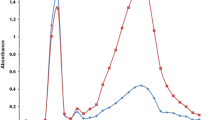Summary
A microscope fluorometric technique is described which permits not only the visual identification of reticulocytes under the fluorescence microscope but also the determination of their relative stage of maturation to normocytes. The technique is based on a specific staining procedure which results in a fluorescent complex between the reticulocytic RNA and acridine orange. Thus, the relative mass of RNA in the individual reticulocytes can be measured by means of microscope fluorometry. As the reticulocytic RNA content decreases and finally disappears during the final maturation process of reticulocytes after their release into the peripheral blood stream, the fluorescence signal indicates the relative degree of this maturation. A characteristic frequency distribution of this parameter can be obtained for a given blood sample by microscope fluorometry measuring 200 to 300 reticulocytes.
The preliminary use of this technique for following up the course of two cases of hemolytic anemia and one of pernicious megaloblastic anemia during their treatment demonstrates the potential diagnostic value of this technique of identifying the change of the reticulocyte maturation distribution in addition to the reticulocyte count. Satisfactory agreement between the microscope fluorometric results and those obtained by counting separately the four reticulocytic maturation stages according toHeilmeyer andWesthäuser has been achieved. The possibility of obtaining quantitative and comparable results by use of this method may be considered a general advantage and a promising basis for the development of an automated technique.
Zusammenfassung
Es wird eine mikroskopfluorometrische Methode beschrieben, die über die visuelle Identifizierung von Retikulozyten unter dem Fluoreszenzmikroskop hinaus auch eine Bestimmung ihres relativen Reifungsgrades ermöglicht. Die Methode beruht auf einem speziellen Färbungsverfahren zur Erzielung eines fluoreszierenden Komplexes zwischen der Retikulozyten-RNS und Akridinorange. Die relative RNS-Menge in den einzelnen Retikulozyten kann somit mikroskop-fluorometrisch gemessen werden. Da der RNS-Gehalt der Retikulozyten im Zuge ihrer Reifung nach Entlassung in den peripheren Blutstrom abnimmt und schließlich völlig verschwindet, gibt das Fluoreszenzsignal das relative Stadium dieser Reifung an. Durch mikroskopfluorometrische Messung dieses Parameters an 200 bis 300 Retikulozyten läßt sich eine für eine gegebene Blutprobe charakteristische Häufigkeitsverteilung der verschiedenen Reifungsstadien ermitteln.
Die erste orientierende Anwendung dieser Methode zur Verfolgung der Retikulozytendynamik in zwei Fällen von hämolytischer Anämie und in einem Fall von perniziöser megaloblastischer Anämie während der Retikulozytenkrise bestätigt den potentiellen diagnostischen Wert der Methode, die über die Bestimmung der Retikulozytenkonzentration hinaus Veränderungen der Retikulozyten-Reifungsgradvertéilung festzustellen gestattet. Die Ergebnisse der mikroskopfluorometrischen Reifungsgradbestimmung und der visuellen Einstufung der Retikulozyten in die Reifungsgradstadien I bis IV nachHeilmeyer undWesthäuser ergaben befriedigende Übereinstimmung. Es darf als ein genereller Vorteil dieser Methode gelten, daß sie nicht nur streng vergleichbare und reproduzierbare Meßergebnisse liefert, sondern auch als eine brauchbare Grundlage für die Entwicklung eines automatischen Bestimmungsverfahrens angesehen werden kann.
Similar content being viewed by others
Literature
Becker Hj., Knecht L. H. & Straschil F.: Die makrozytäre Regeneration der Erythropoese. Acta haemat.43, 144 (1970).
Bessis M.: Living blood cells and their ultrastructure, p. 134 ff. Springer Verlag Berlin-Heidelberg-New York 1973.
Brecher G. & Stohlman F.: The macrocytic response to erythropoietic stimulation. In: Erythropoiesis (Ed. L. O. Jacobson and M. Doyle). p. 216, Grune & Stratton New York, 1962.
Cline M. J. & Berlin N. I.: The reticulocyte count as an indicator of the rate of erythropoiesis, Am. J. Clin. Path.39, 121 (1963).
van Dilla M. A. & Spalding J. F.: Erythrocyte volume distribution during recovery from bone marrow arrest, Nature (Lond.)213, 708 (1967).
Finch C. A., Hanson M. L. & Donohue D. M.: Kinetics of erythropoiesis. A comparison of response to anemia induced by phenylhydracine and by blood loss. Amer. J. Physiol.197, 761 (1959).
Heilmeyer L. & Westhäuser R.: Reifungsstadien an überlebenden Reticulozyten in vitro und ihre Bedeutung für die Schätzung der täglichen Hämoglobinproduktion in vivo. Z. Klin. Med.121, 361 (1932).
Hillman R. S.: Characteristics of Marrow Production and Reticulocyte Maturation in Normal Man in Response to Anemia, J. Clin. Invest.48, 443 (1969).
Kosenow W.: Über den Strukturwandel der basophilen Substanz junger Erythrozyten im Fluoreszenzmikroskop, Acta haemat.7, 360 (1952).
Marmont A.: Acridine orange fluorescence microscopy in haematology, Proc. 7th Congr. Europ. Soc. Haemat. Part.2, 361 (1960).
Reiff R. H., Nutter J. Y., Donohue D. M. & Finch C. A.: The relative number of marrow reticulocytes. Amer. J. Clin. Path.30, 199 (1958).
Schiffer L. M.: Fluorescence microscopy with acridine orange: a study of hemopoietic cells in fixed preparation, Blood19, 200 (1962).
Schlosshardt H. & Heilmeyer L.: Blutzellen im Fluoreszenzlicht, Jenaische Zeitschr. Med. Naturw.75, 90 (1942).
Seno S., Miyahara M., Asakura H., Ochi O., Matsuoka K. & Toyama T.: Macrocytosis resulting from early denucleation of erythroid precursors, Blood24, 582 (1964).
Thaer A.: Microfluorometric analysis of the reticulocytic population in peripheral blood of mammals. In: Cytology Automation (D. M. D. Evans ed.) p. 189. E. & S. Livingstone, Edinburgh 1970.
Thaer' A., Eder H., Fritsche H., Hugemann B. & Sengbusch G. von: Eine fluoreszenzmikroskopische Methode zur Bestimmung der Retikulozytenkonzentration im Blut und ihre Automatisierung (in Vorbereitung).
Author information
Authors and Affiliations
Rights and permissions
About this article
Cite this article
Thaer, A., Becker, H. Microscope fluorometric investigations on the reticulocytic maturation distribution as diagnostic criterion of disordered erythropoiesis. Blut 30, 339–348 (1975). https://doi.org/10.1007/BF01633653
Received:
Issue Date:
DOI: https://doi.org/10.1007/BF01633653




